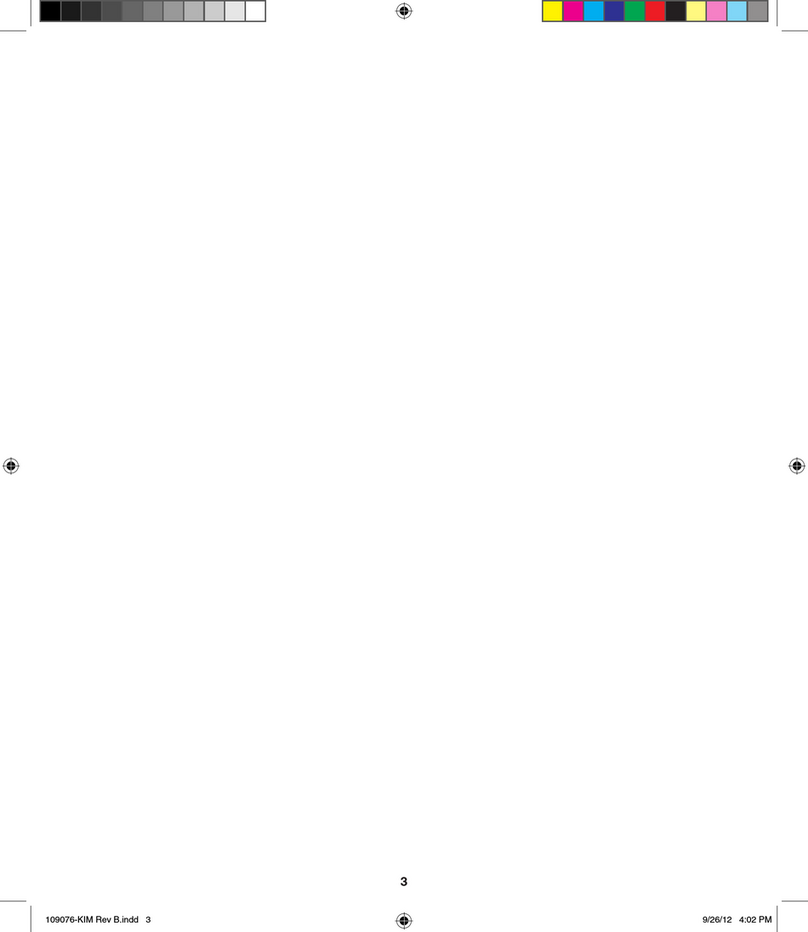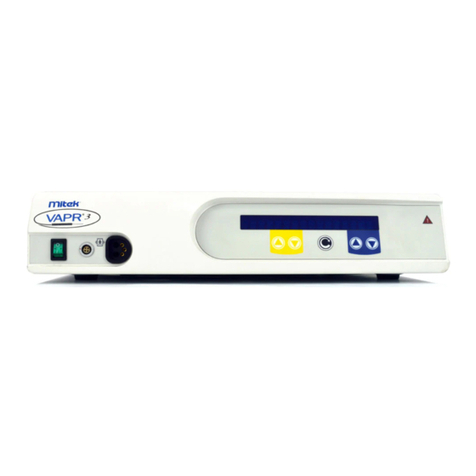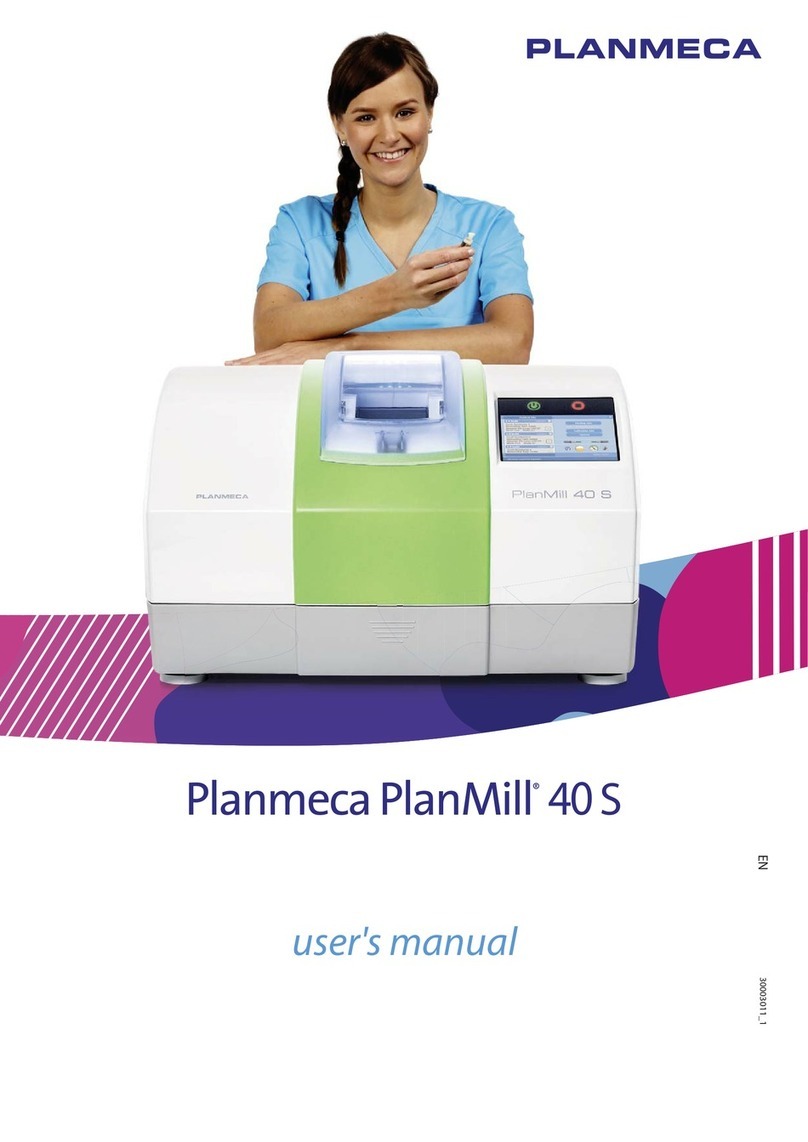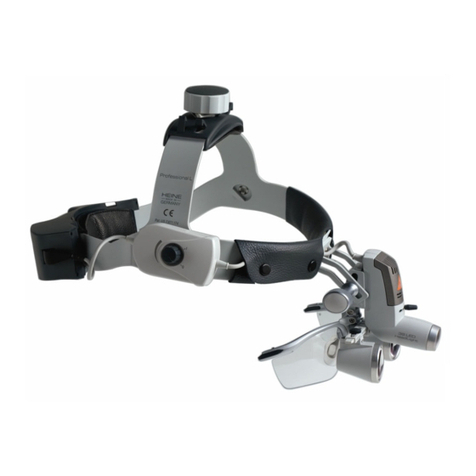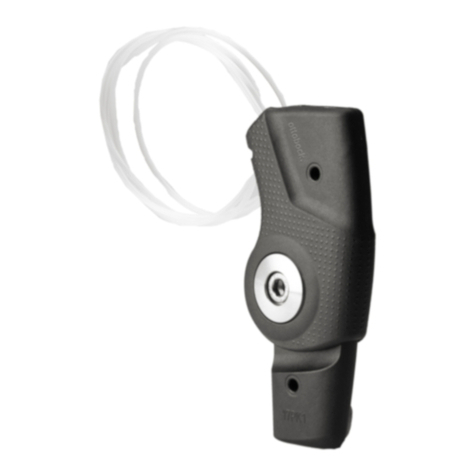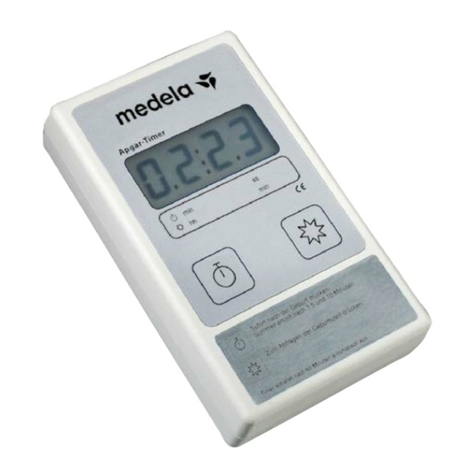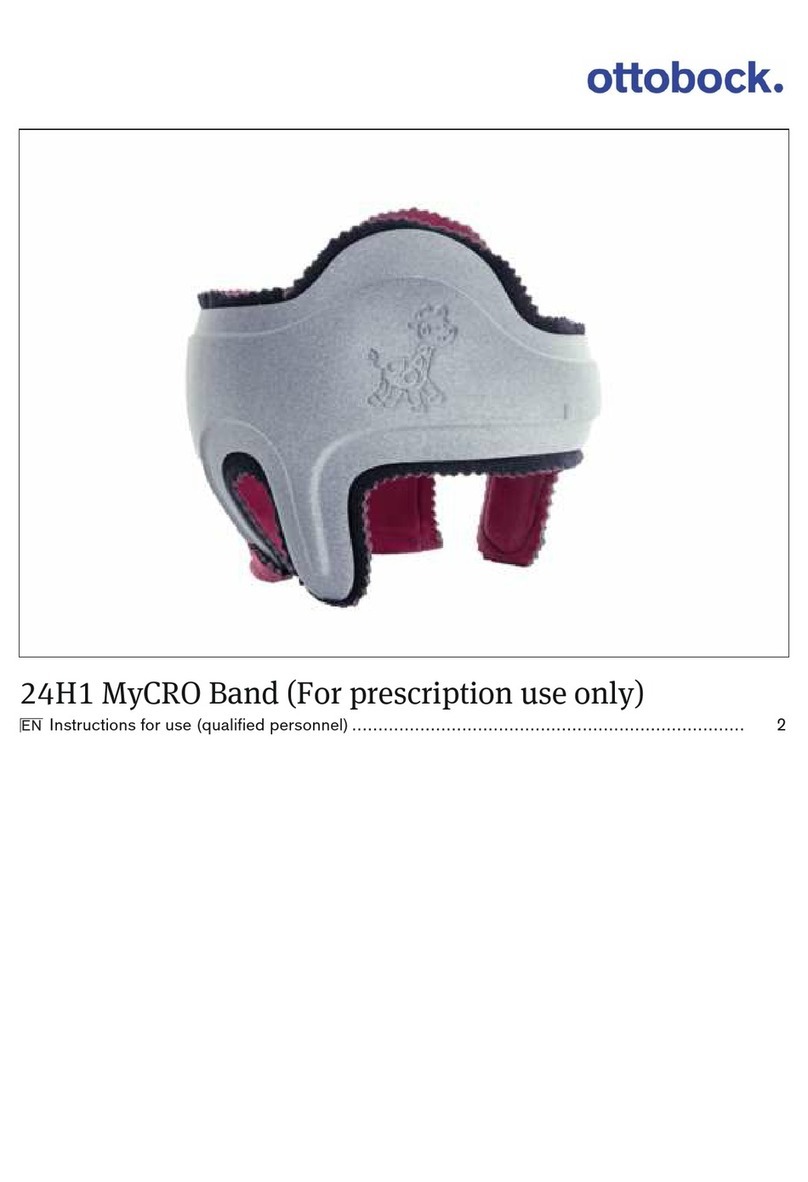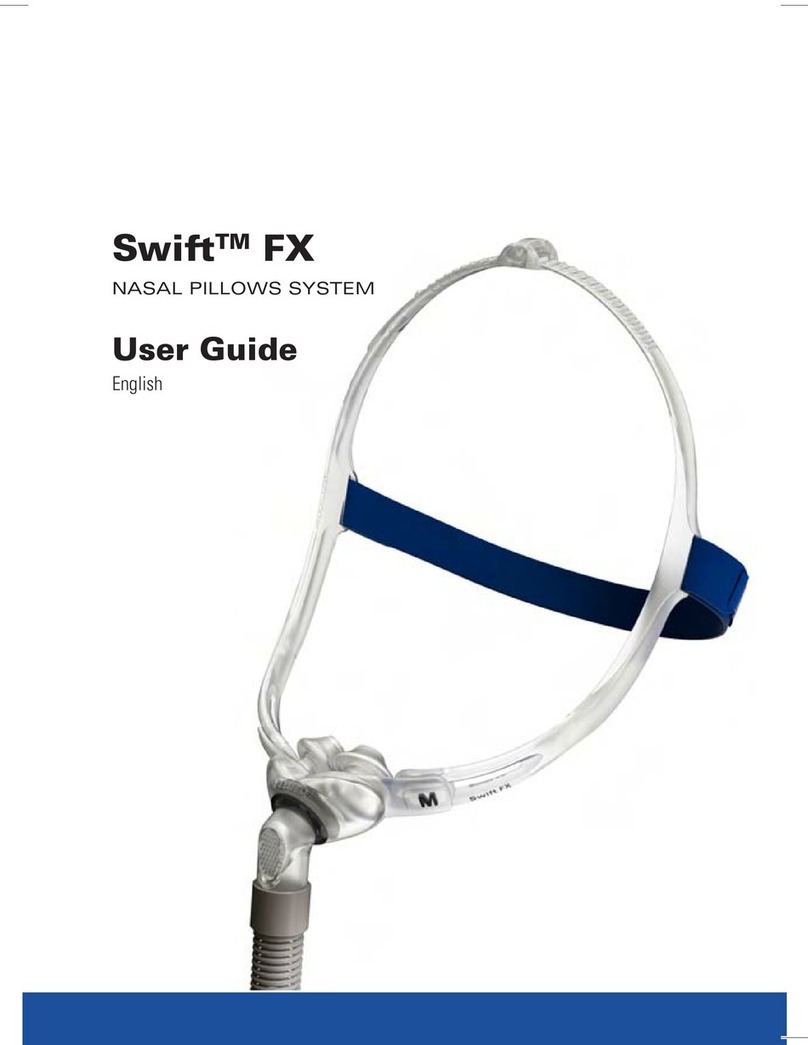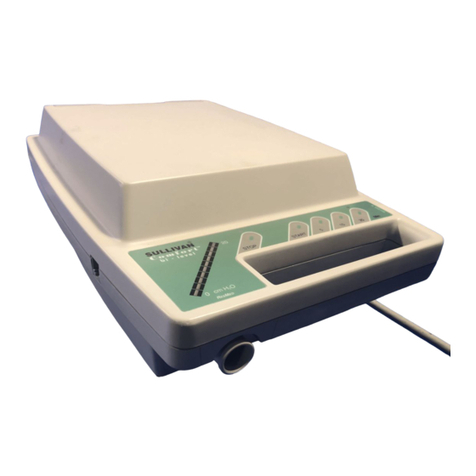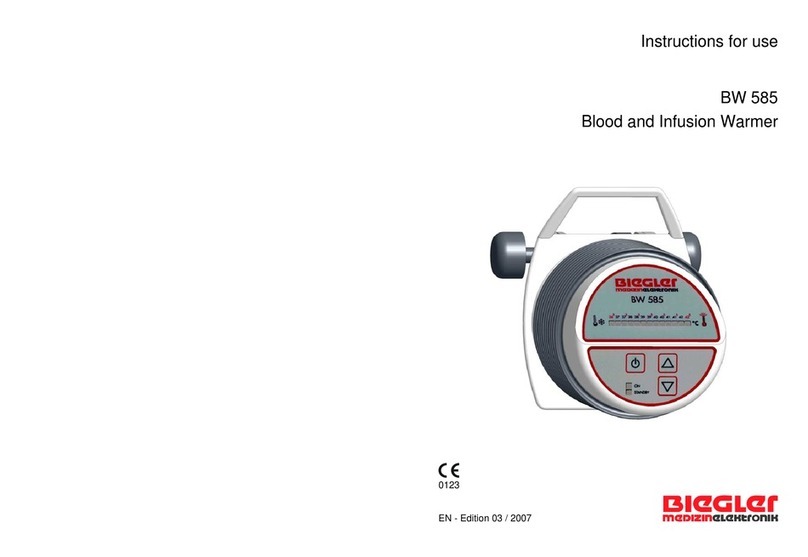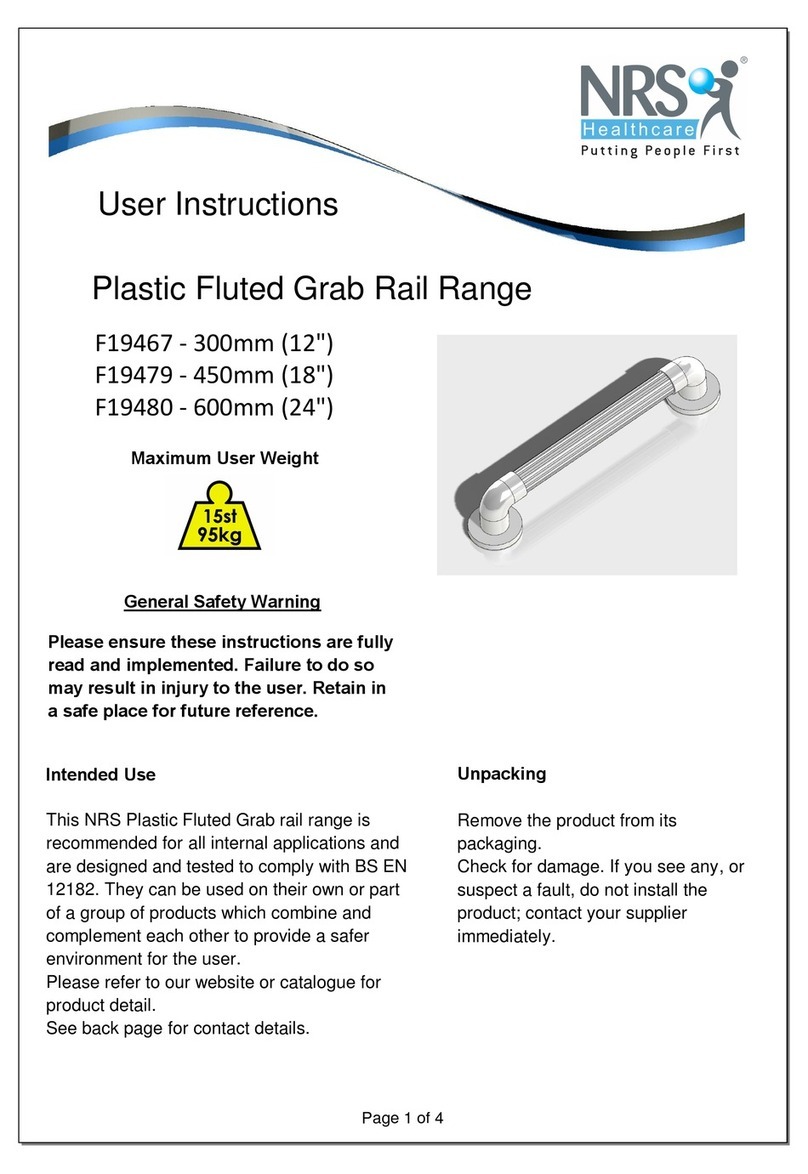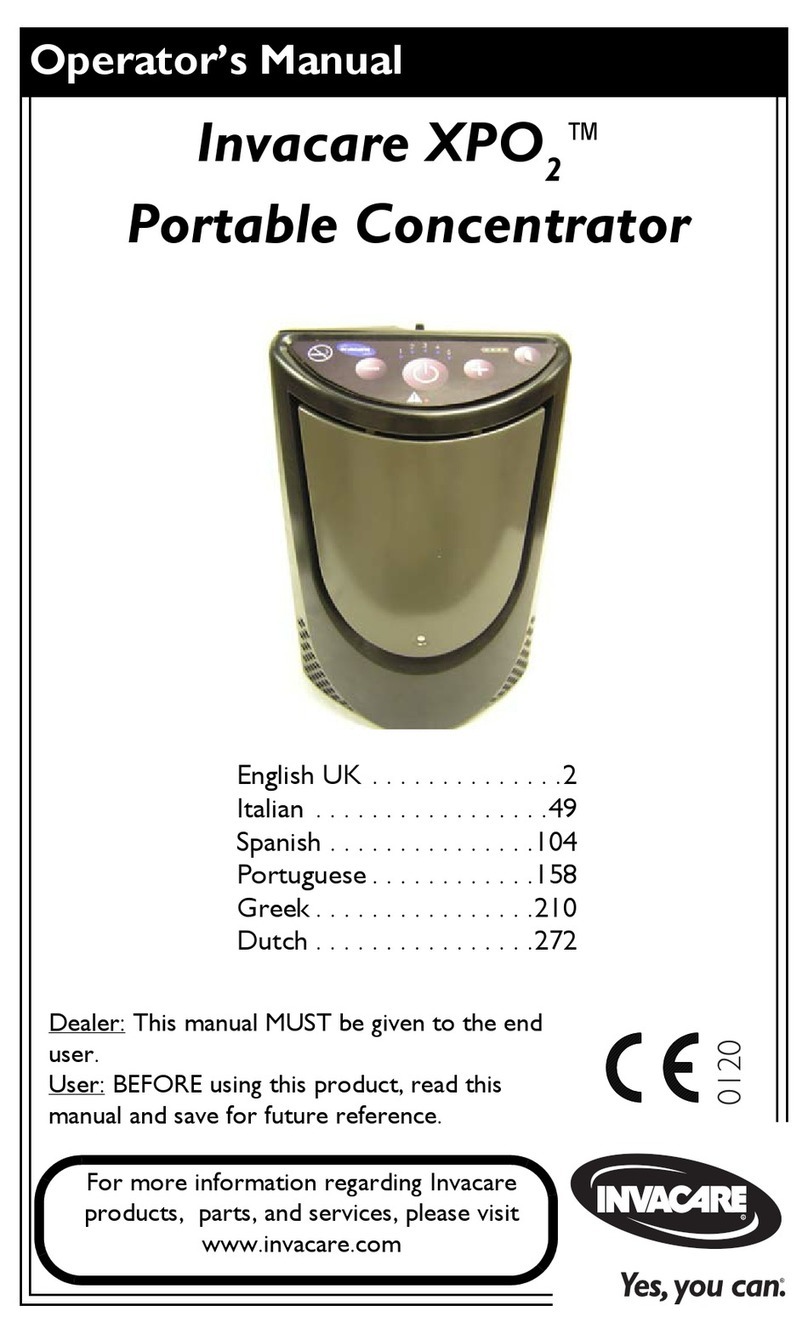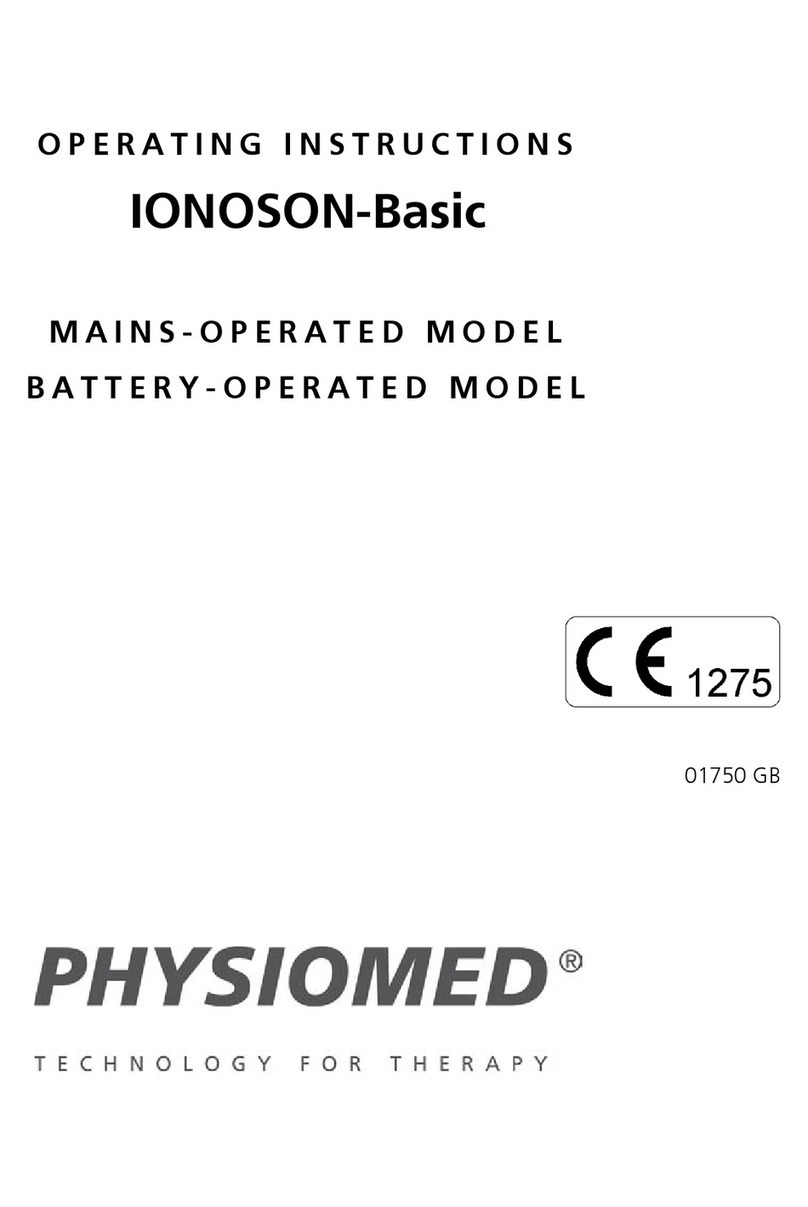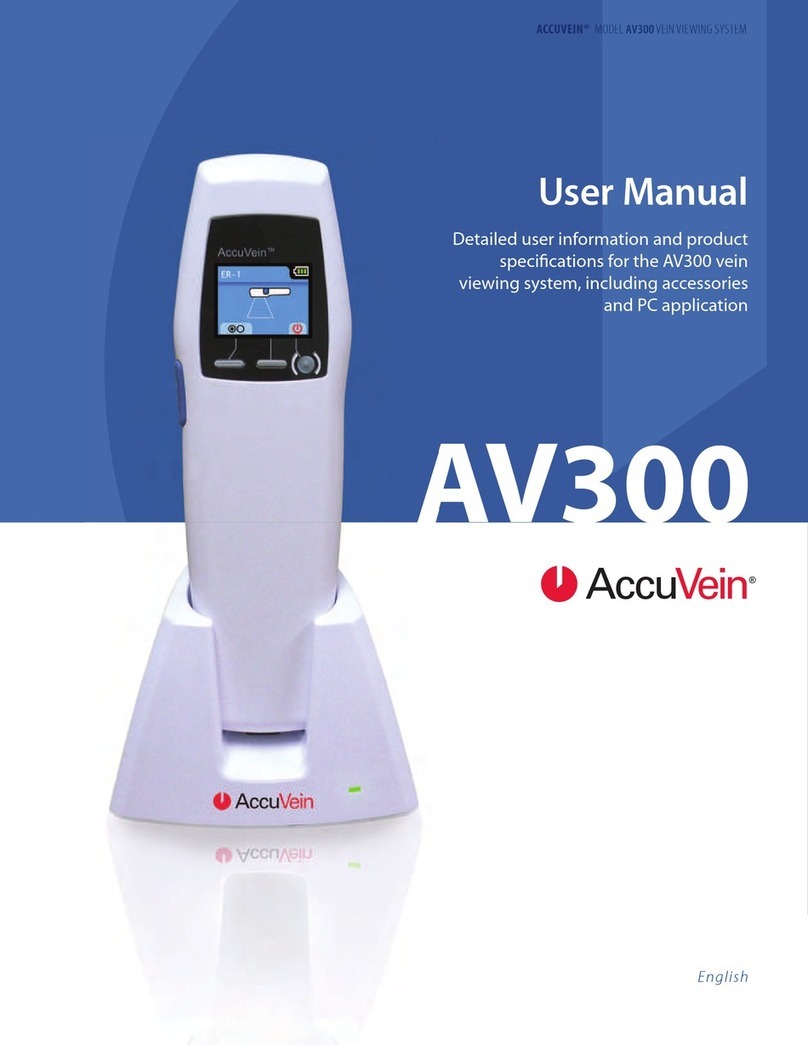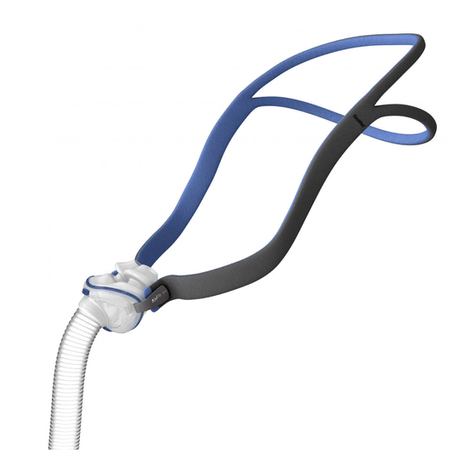DePuy Mitek Mini QUICKANCHOR Plus User manual

Mini
QUICKANCHOR®
Plus
P/N: 109169
Rev: F Revised 09/12
©2007-2012 DePuy Mitek

2
FIGURE 1

3
ENGLISH
Mini QUICKANCHOR®Plus
DESCRIPTION
The Depuy Mitek Mini QUICKANCHOR Plus is a
preloaded disposable anchor/inserter assembly designed
to facilitate the delivery and installation of Depuy Mitek
Mini Anchor into bone.
CONTENTS
Contents are STERILE unless packaging is damaged
or opened. Resterilization by any method is not
recommended.
MATERIALS
Handle: Polycarbonate, Polyurethane and ABS.
Shaft: Stainless Steel (Mini shaft tip is Nickel Titanium
Alloy).
Anchor: Nickel Titanium Alloy (NiTi) & 6Al-4V ELI
Titanium.
Suture: ORTHOCORD®Suture is a synthetic, sterile,
braided, composite suture composed of dyed absorbable
polydiaxanone (PDS®) and undyed non-absorbable
polyethylene. The partially absorbable suture is coated
with copolymer of 90% caprolactone and 10% glycolide.
The PDS copolymer has been shown to be nonantigenic,
nonpyrogenic and elicits only a slight tissue reaction
during absorption.
Needles: Surgical stainless steel, see package label for
type and size.
Drill Bit: Stainless steel
INDICATIONS
The Depuy Mitek Mini QUICKANCHOR Plus is intended
for fixation of USP size #0 through 2/0 suture to bone for
the indications listed below.
Shoulder: Bankart repair.
Ankle: Mid-foot reconstruction.
Foot: Hallux valgus reconstruction.
Hand: Ulnar or lateral collateral ligament reconstruction.
Wrist: Scapholunate ligament reconstruction.

4
CONTRAINDICATIONS
1.
Reattachment of intracapsular knee ligaments (ACL & PCL).
2. Surgical procedures other than those listed in the
INDICATIONS section.
3. Pathologic conditions of bone, such as cystic
changes or severe osteopenia, which would impair
its ability to securely fix the Depuy Mitek Anchor, are
contraindicated.
4. Pathological changes in the soft tissues sutured to the
bone which would prevent its secure fixation by the
suture are contraindicated.
5. Comminuted bone surface, which would militate
against secure fixation of the Depuy Mitek Anchor, is
contraindicated.
6. Physical conditions that would eliminate or tend to
eliminate adequate implant support or retard healing,
i.e., blood supply limitation, previous infections, etc.
are contraindicated.
7. Conditions which tend to preempt the patient’s ability
or the healing period, such as senility, mental illness
or alcoholism are contraindicated.
8. The Depuy Mitek Anchor is not designed for and
should never be used to attach artificial ligaments or
other implants.
WARNING:
Users should be familiar with surgical procedures and
techniques involving absorbable and non-absorbable
suture before employing ORTHOCORD Suture for wound
closure, as risk of wound dehiscence may vary with the
site of application and the suture material used.
This product is for single-use only. It has not been designed
to be re-used/re-sterilized. Reprocessing may lead to
changes in material characteristics such as deformation
and material degradation which may compromise device
performance. Reprocessing of single use devices can also
cause cross-contamination leading to patient infection.
These risks may potentially affect patient safety.
PRECAUTIONS
Titanium alloys contain metals which may stimulate
allergic hyper-sensitive responses by the immune system.
The metals used are titanium, aluminum, vanadium and
nickel (Ti, Al, V and Ni). When sensitivity is anticipated,
appropriate pre-operative testing should be conducted. A
surgeon should not attempt clinical use of Depuy Mitek

5
Anchors before reviewing instructions for use and
rehearsing the installation procedure in a skills laboratory.
Magnetic Resonance Imaging (MRI) Information
Non-clinical testing has demonstrated that DePuy Mitek
Metal Implants are MR Conditional. A patient with
a metallic implant can be scanned safely under the
following conditions:
3.0 Tesla Systems:
• Staticmagneticeldof3.0Tesla.
• Highestspatialgradientmagneticeldof
720 Gauss/cm or less.
MRI Related Heating
• MaximumMRsystemreported,wholebody-averaged
specific absorption rate (SAR) of 2.9 W/kg for 15
minutes of scanning (i.e., per pulse sequence).
• MRIrelatedheatingwasassessedforthe
representative configurations of the Mitek metal
implants following guidelines provided in ASTM
F2182-02a. A maximum temperature change equal
to or less than 2.0°C was observed during testing
(parameters listed below).
Parameters:
• MaximumMRsystem-reported,wholebody-averaged
SAR of 2.9 W/kg
• 15-minutedurationMRscanning(i.e.,perpulse
sequence).
• 3TeslaMRSystem(EXCITE®MR Scanner, Software
G3 .0-052B, General Electric Healthcare, Milwaukee,
WI) using a transmit/receive RF body coil.
Artifact Information
MR Image quality may be compromised if the area of
interest is in the exact same area or relatively close
to the position of the Mitek metal implant. Therefore,
optimization of MR imaging parameters to compensate
for the presence of this device may be necessary.
INSTRUCTIONS FOR USE
1. Prepare the bone hole site using the sterile drill bit
provided in the package. Proper drill hole size is
2.0mm x 9.7mm. Minimum hole spacing is 5mm. Bone
stock must be adequate to allow proper placement.
WARNING: MOVINGTHE POWER DRILL UNIT OFF
THE AXIS OF THE HOLE WHILE DRILLING MAY
CAUSE THE DRILL TIP TO BREAK.

6
2. Establish axial alignment of the QUICKANCHOR Plus
to the drill hole and push in to insert the Anchor.
WARNING: DO NOT TWIST OR APPLY BENDING
FORCE TO THE INSERTER AS EITHER MAY DAMAGE
THE ANCHOR, SUTURE OR INSERTER TIP.
WARNING: INCOMPLETE INSERTION OR POOR
BONE QUALITY MAY RESULT IN ANCHOR PULLOUT.
3. Retract the Slide Cover to the “Full Open” position
to release the Anchor, Suture and Needles
from the QUICKANCHOR Plus Handle and the
Suture Retaining Cap (FIGURE 1). Remove the
QUICKANCHOR Plus Tip from the drill hole and
gently pull back allowing the Suture and Needles to
feed out of the handle and paper carrier.
WARNING: DO NOT ATTEMPT TO REMOVE
QUICKANCHOR PLUS TIP FROM DRILL HOLE UNTIL
THE SLIDE COVER IS RETRACTEDTO THE OPEN
POSITION.
4. Apply tension (approximately 8 lbs.) on the suture
lengths to set the Anchor in the bone.
WARNING: EXCESSIVE TENSION MAY OVERLOAD
THE ANCHOR OR SUTURE.
5. Complete the tissue reattachment.
STERILIZATION
The Depuy Mitek Mini QUICKANCHOR Plus is provided
sterile. Do not resterilize.
STORAGE
Store below 25°C (77°F), away from moisture and direct
heat. Do not use after expiration date.

7
ESPAÑOL
Mini QUICKANCHOR®Plus
DESCRIPCIÓN
El anclaje Mini QUICKANCHOR Plus de Mitek es una
unidad de anclaje e insertador desechable precargada,
diseñada para facilitar la aplicación y fijación de los
anclajes de Mitek.
CONTENIDO
El contenido es ESTÉRIL a menos que el envase esté
dañado o abierto. Se desaconseja la reesterilización por
cualquier método.
MATERIALES
Mango: policarbonato, poliuretano y ABS.
Vástago: acero inoxidable (la punta del vástago Mini es
de aleación de níquel y titanio).
Ancla: aleación de níquel y titanio (NiTi) y titanio
6Al-4V ELI.
Sutura: la sutura ORTHOCORD®es una sutura de
composite sintética, estéril, trenzada, compuesta de
polidioxanona absorbible teñida (PDS®), y polietileno
no absorbible sin teñir. La sutura parcialmente
absorbible está revestida con un copolímero de 90% de
caprolactona y 10% de glicólido. Se ha comprobado que
el copolímero PDS es no antigénico, no pirogénico y sólo
genera una leve reacción del tejido durante la absorción.
Agujas: acero inoxidable quirúrgico; ver tipo y tamaño en
la etiqueta del envase.
Broca: acero inoxidable
INDICACIONES
El anclaje Mini QUICKANCHOR Plus Super de Mitek
está indicado para la fijación de sutura calibre USP nº 2 a
2/0 a hueso en los siguientes casos:
Hombro: reparación de Bankart.
Tobillo: reconstrucción de la parte media del pie
Pie: reconstrucción hallux valgus.
Mano: reconstrucción del ligamento colateral ulnar o lateral.
Muñeca: reconstrucción de los ligamentos escafolunares.
CONTRAINDICACIONES
1. Reinserción de los ligamentos intracapsulares
de la rodilla (cruzados anterior y posterior).

8
2. Procedimientos quirúrgicos que no sean los
enumerados en la sección INDICACIONES.
3. Procesos patológicos del hueso, tales como alteraciones
císticas u osteopenia grave, que puedan alterar su
capacidad para fijar con firmeza el anclaje DePuy Mitek.
4. Está contraindicado en caso de cambios patológicos
de los tejidos blandos suturados al hueso que puedan
impedir una fijación segura con sutura.
5. Está contraindicado el uso en superficies óseas
conminutas, que dificultan la fijación segura del
anclaje Depuy Mitek.
6. Está contraindicado el uso en caso de problemas
físicos que pudiesen eliminar, o tender a eliminar,
el apoyo adecuado del implante o retardar su
cicatrización, tales como disminución del riego
sanguíneo e infecciones previas.
7. Está contraindicado el uso en estados que tiendan a
alterar la capacidad del paciente durante el proceso
de cicatrización, tales como senilidad, enfermedades
mentales o alcoholismo.
8. El anclaje Depuy Mitek no ha sido diseñado para
fijar ligamentos artificiales ni otros implantes y nunca
debe ser empleado para este fin.
ADVERTENCIA:
Los usuarios deben encontrarse familiarizados con los
procedimientos y técnicas quirúrgicas que implican el uso
de suturas absorbibles y no absorbibles antes de utilizar la
sutura ORTHOCORD para el cierre de una herida, ya que
el riesgo de dehiscencia de la herida puede variar según el
lugar de aplicación y el material de sutura utilizado.
Este producto es para un solo uso. No está diseñado para
ser reutilizado ni reesterilizado. Su reprocesamiento puede
producir cambios en las características de los materiales,
como deformación y degradación, lo que puede afectar
al funcionamiento del dispositivo. El reprocesamiento de
dispositivos para un solo uso también puede producir
contaminación cruzada, lo que puede causar infecciones
en el paciente. Estos riesgos podrían afectar a la
seguridad del paciente.
PRECAUCIONES
Las aleaciones de titanio contienen metales que pueden
estimular respuestas alérgicas de hipersensibilidad en
el sistema inmune. Los metales utilizados son titanio,
aluminio, vanadio y níquel (Ti, Al, V y Ni). En caso
de prever sensibilidad por parte del paciente, deben

9
realizarse las pruebas preoperatorias adecuadas. El
cirujano debe leer detenidamente las instrucciones de
uso antes de proceder al uso clínico de los anclajes
DePuy Mitek, así como practicar el procedimiento de
instalación en un laboratorio de habilidades clínicas.
Información sobre adquisición de imágenes por
resonancia magnética (RM)
Las pruebas no clínicas han demostrado que los
implantes metálicos de DePuy Mitek presentan ciertas
condiciones para RM. Un paciente con un implante
metálico puede ser objeto de una exploración de forma
segura en las siguientes condiciones:
Sistemas de 3,0 Tesla:
• Campomagnéticoestáticode3,0Tesla.
• Mayorgradientedecampomagnéticoespacialde
720 Gauss/cm o menos.
Calentamiento relacionado con la RM
• Tasadeabsorciónespecíca(SAR)máxima,
promediada para todo el cuerpo, comunicada por
el sistema de RM, de 2,9 W/kg durante 15 minutos
de exploración (es decir, por cada secuencia de
impulsos).
• ElcalentamientorelacionadoconlaRMseevaluóen
las configuraciones representativas de los implantes
metálicos de Mitek siguiendo las directrices previstas
en la norma ASTM F2182-02a. Se observó un
cambio máximo de temperatura igual o inferior a
2,0°C durante la prueba (parámetros indicados a
continuación).
Parámetros:
• Tasadeabsorciónespecíca(SAR)máxima,
promediada para todo el cuerpo, comunicada por el
sistema de RM, de 2,9 W/kg
• 15minutosdeduracióndelaexploracióndeRM(es
decir, por cada secuencia de impulsos).
• SistemadeRMde3Tesla(escánerdeRMEXCITE®,
software G3 .0-052B, General Electric Healthcare,
Milwaukee, WI) utilizando una bobina de cuerpo de
RF de transmisión/recepción.
Información sobre artefactos
La calidad de una imagen por RM puede verse
comprometida si el área de interés se encuentra
exactamente en el lugar donde se encuentra el implante
de metal de DePuy Mitek o relativamente cerca de este.
Por lo tanto, es posible que sea necesario optimizar los

10
parámetros de las imágenes de RM a fin de compensar
la presencia de este dispositivo.
INSTRUCCIONES DE USO
1. Prepare el lugar donde realizará el orificio en el
hueso utilizando la broca estéril suministrada en el
envase. El tamaño adecuado de orificio es 2,0mm x
9,7mm. El espacio mínimo entre orificios es de 5mm.
El hueso debe estar en buen estado para permitir una
colocación correcta.
ADVERTENCIA: SI SE MUEVE EL TALADRO
ELÉCTRICO FUERA DEL EJE DEL ORIFICIO
MIENTRAS QUE SE ESTÁ TALADRANDO LA BROCA
PODRÍA ROMPERSE.
2. Determine la alineación axial del anclaje Super
QUICKANCHOR Plus con el orificio taladrado e
introdúzcalo ejerciendo presión sobre él.
ADVERTENCIA: NO TUERZA NI APLIQUE FUERZA
DE TORSIÓN AL INSERTADORYA QUE PODRÍA
DAÑAR EL ANCLAJE, LA SUTURA O LA PUNTA DEL
INSERTADOR.
ADVERTENCIA: UNA INSERCIÓN INCOMPLETA
O UNA CALIDAD DE HUESO DEFICIENTE PUEDE
CAUSAR QUE EL ANCLAJE SE SALGA.
3. Deslice la cubierta a la posición “Full Open” para liberar
el Anclaje, la Sutura y las Agujas de la empuñadura
y la tapa de retención de la sutura del anclaje
QUICKANCHOR Plus (Figura 1). Extraiga la punta del
anclaje QUICKANCHOR Plus del orificio taladrado y
tire suavemente hacia atrás para liberar la sutura y las
agujas de la empuñadura y del soporte de papel.
ADVERTENCIA: NO INTENTE RETIRAR LA PUNTA
QUICKANCHOR PLUS DEL ORIFICIO DEL TALADRO
HASTA QUE LA CUBIERTA DESLIZANTE ESTÉ
RETRAÍDA A LA POSICIÓN ABIERTA.
4. Aplique tensión (aproximadamente 3,5 kg) a lo largo
de la sutura para fijar el anclaje en el hueso.
ADVERTENCIA: LA TENSIÓN EXCESIVA PUEDE
SOBRECARGAR EL ANCLAJE O LA SUTURA.
5. Complete la unión del tejido.

11
ESTERILIZACIÓN
El anclaje Mini QUICKANCHOR Plus de Mitek se
suministra estéril. No reesterilice.
ALMACENAMIENTO
Guardar a una temperatura inferior a los 25°C en un lugar
alejado de la humedad y de la exposición directa al calor.
No utilizar una vez transcurrida la fecha de caducidad.
ITALIANO
Mini QUICKANCHOR®Plus
DESCRIZIONE
Il dispositivo Depuy Mitek Mini QUICKANCHOR®Plus è
un sistema composto da ancora e introduttore monouso,
premontato e progettato per facilitare l’inserimento delle
ancore Depuy Mitek Mini all’interno dell’osso.
CONTENUTO
Il contenuto è STERILE purché la confezione non sia
stata danneggiata o aperta. Non se ne consiglia la
risterilizzazione con alcun metodo.
MATERIALI
Impugnatura: Policarbonato, poliuretano e ABS.
Stelo: acciaio inossidabile (la punta dello stelo
dell’ancora Mini è in lega di nichel-titanio).
Ancora: lega di titanio-nichel (NiTi) e titanio 6Al-4V ELI.
Sutura: ORTHOCORD®è una sutura sterile composita
intrecciata e sintetica composta da polidiossanone
(PDS®) assorbibile colorato e polietilene non assorbibile
non colorato. La sutura parzialmente assorbibile è
rivestita con un copolimero composto dal 90% di
caprolattone e dal 10% di glicolide. Benché sia stato
dimostrato che il copolimero PDS è non antigenico e
apirogeno, può tuttavia provocare una leggera reazione
del tessuto durante l’assorbimento.
Aghi: acciaio inossidabile chirurgico; per il tipo e la
misura consultare l’etichetta sulla confezione.
Punta da trapano: acciaio inossidabile
INDICAZIONI
Il dispositivo Depuy Mitek Mini QUICKANCHOR Plus
è concepito per il fissaggio della sutura USP misura da
#0 a 2/0 all’osso per le indicazioni elencate di seguito.

12
Spalla: riparazione di Bankart.
Caviglia: ricostruzione dei legamenti e tendini della
caviglia.
Piede: ricostruzione dell’alluce valgo.
Mano: ricostruzione legamento collaterale laterale o
ulnare.
Polso: ricostruzione del legamento scafolunato.
CONTROINDICAZIONI
1. Riattacco di legamenti intracapsulari del ginocchio
(ACL e PCL).
2. Interventi chirurgici diversi da quelli elencati nella
sezione INDICAZIONI.
3. Sono controindicate le condizioni patologiche
dell’osso, quali le variazioni cistiche o una grave
osteopenia che potrebbe pregiudicare la sua capacità
di fissare in sicurezza l’ancora DePuy Mitek.
4. Sono controindicate modifiche patologiche dei tessuti
molli suturati all’osso che impediscono il fissaggio
sicuro della sutura.
5. È controindicata una superficie ossea comminuta che
ostacola il fissaggio sicuro dell’ancora Depuy Mitek.
6. Sono controindicate le condizioni fisiche che eliminano
o tendono ad eliminare un adeguato supporto
dell’impianto o ritardare la guarigione, ad esempio
limitato apporto ematico, infezioni precedenti, ecc.
7. Sono controindicate condizioni che tendono a limitare
le capacità del paziente o il periodo di guarigione,
quali senilità, malattie mentali o alcolismo.
8. L’ancora Depuy Mitek non è stata progettata per
questo scopo e non deve mai essere usata per
collegare legamenti artificiali o altri impianti.
AVVERTENZA:
Prima di utilizzare la sutura ORTHOCORD per la
chiusura della lesione, gli operatori devono aver acquisito
esperienza nelle procedure e tecniche chirurgiche in cui
vengono applicate suture assorbibili e non assorbibili, in
quanto il rischio di deiscenza della lesione dipende dal
sito di applicazione e dal materiale utilizzato per la sutura.
Questo prodotto è monouso. Non è stato concepito per
essere riutilizzato/risterilizzato. La rielaborazione può
influire sulle caratteristiche del materiale, causando ad
esempio deformazione e deterioramento del materiale,
con conseguente compromissione delle prestazioni del
dispositivo. La rielaborazione di dispositivi monouso
può anche essere causa di contaminazione crociata

13
con conseguente infezione del paziente. Questi rischi
possono compromettere la sicurezza del paziente.
PRECAUZIONI
Le leghe in titanio contengono dei metalli che possono
stimolare risposte di ipersensibilità allergica da parte del
sistema immunitario. I metalli usati sono titanio, alluminio,
vanadio e nichel (Ti, Al, V e Ni). Se tale sensibilità è
già nota, eseguire test adeguati prima dell’intervento.
Il chirurgo deve procedere all’uso clinico delle ancore
Depuy Mitek solo dopo aver letto attentamente le
istruzioni per l’uso ed essersi esercitato nella procedura
di installazione corso di abilità pratica.
Informazioni sulla risonanza magnetica per immagini
(RMI)
Test non clinici hanno dimostrato che gli impianti
metallici DePuy Mitek sono a compatibilità RM
condizionata. Un paziente con un impianto metallico
può essere sottoposto a scansione in sicurezza, se si
osservano le seguenti condizioni:
Sistemi da 3,0 tesla:
• Campomagneticostaticodi3,0tesla.
• Campomagneticocongradientespazialemassimo
pari a 720 Gauss/cm.
Riscaldamento dovuto alla RM
• Tassomassimodiassorbimentospecico(SAR)
mediato per l’intero organismo riportato dal sistema
RM di 2,9 W/kg per 15 minuti di scansione (cioè per
sequenza di impulsi).
• IlriscaldamentodovutoallaRMèstatovalutatoperle
configurazioni rappresentative degli impianti metallici
Mitek seguendo le linee guida fornite dalla ASTM
F2182-02a. Durante i test è stata osservata una
variazione massima di temperatura uguale o inferiore
a 2,0°C (segue l’elenco dei parametri).
Parametri:
• Tassomassimodiassorbimentospecico(SAR)
mediato per l’intero organismo riportato dal sistema
RM di 2,9 W/kg
• 15minutidiscansioneMR(cioèpersequenzadi
impulsi).
• SistemadiRMda3tesla(scannerRMEXCITE®,
Software G3 0.0-052B, General Electric Healthcare,
Milwaukee, WI) con l’utilizzo di una bobina di
trasmissione/ricezione a RF per il corpo.

14
Informazioni sugli artefatti
La qualità dell’immagine di risonanza magnetica (RM)
può risultare compromessa se l’area di interesse si trova
nell’esatta posizione dell’impianto metallico DePuy Mitek
o relativamente vicina ad essa. Pertanto potrà essere
necessaria un’ottimizzazione dei parametri RM per
compensare la presenza di questo dispositivo.
ISTRUZIONI PER L’USO
1. Preparare il punto di fresatura dell’osso utilizzando
la punta da trapano sterile fornita nella confezione. Il
foro ha un diametro di 2,0 mm ed è profondo 9,7 mm.
Lo spazio tra i fori deve essere di almeno 5 mm. Per
consentire un posizionamento corretto, è necessario
che la quantità di osso sia adeguata.
AVVERTENZA: SPOSTARE IL TRAPANO DALL’ASSE
DEL FORO DURANTE L’AZIONAMENTO PUÒ
CAUSARE LA ROTTURA DELLA PUNTA DATRAPANO.
2. Stabilire l’allineamento assiale del dispositivo
QUICKANCHOR Plus rispetto al foro di fresatura e
premer per inserire l’ancora.
AVVERTENZA: NON TORCERE O PIEGARE
L’INTRODUTTORE IN QUANTO È POSSIBILE
DANNEGGIARE L’ANCORA, LA SUTURA O LA PUNTA
DELL’INTRODUTTORE.
AVVERTENZA: UN INSERIMENTO INCOMPLETO
O UNA SCARSA QUALITÀ OSSEA POSSONO
PROVOCARE LA FUORIUSCITA DELL’ANCORA.
3. Far scorrere il coperchio dell’impugnatura in posizione
“completamente aperto” per rilasciare l’ancora, la sutura
e gli aghi dall’impugnatura e dal cappuccio che contiene
la sutura della QUICKANCHOR Plus (Fig. 1). Rimuovere
l’applicatore della QUICKANCHOR Plus dal foro e tirare
indietro delicatamente, consentendo alla sutura e agli
aghi di fuoriuscire dall’impugnatura e dal porta-carta.
AVVERTENZA: NON TENTARE DI RIMUOVERE
L’APPLICATORE DELL’UNITÀ QUICKANCHOR PLUS
DAL FORO DI FRESATURA FINCHÉ IL COPERCHIO
NON VIENE PORTATO IN POSIZIONE APERTA.
4. Per fissare l’ancora nell’osso, applicare una tensione
(circa 3,6 kg) sulle suture.

15
AVVERTENZA: UNA TENSIONE ECCESSIVA PUÒ
SOVRACCARICARE L’ANCORA O LA SUTURA.
5. Completare il riattacco del tessuto.
STERILIZZAZIONE
Il dispositivo Mitek Mini QUICKANCHOR Plus viene
fornito sterile. Non risterilizzare.
CONSERVAZIONE
Conservare a temperature inferiori a 25°C e lontano da
umidità e calore diretto. Non utilizzare oltre la data di
scadenza.
DEUTSCH
Mini QUICKANCHOR®Plus
BESCHREIBUNG
Der Depuy Mitek Mini QUICKANCHOR Plus ist eine
vorkonfektionierte, nicht wiederverwendbare Anker-
Setzinstrument-Kombination, welche die Einbringung und
Befestigung von Depuy Mitek Mini Ankern im Knochen
erleichtert.
INHALT
Der Inhalt ist STERIL, sofern die Packung nicht
beschädigt oder geöffnet ist. Sämtliche Verfahren zur
erneuten Sterilisierung sind nicht zu empfehlen.
MATERIALIEN
Griff: Polykarbonat, Polyurethan und ABS.
Schaft: Edelstahl (Mini-Schaftspitze aus Nickel-Titan-
Legierung).
Anker: Nickel-Titan-Legierung (NiTi) und 6Al-4V ELI Titan.
Nahtmaterial: ORTHOCORD®ist ein steriles
synthetisches, geflochtenes Nahtmaterial, das aus
gefärbtem resorbierbarem Polydioxanon (PDS®) und
ungefärbtem, nicht resorbierbarem Polyethylen hergestellt
ist. Dieses teilweise resorbierbare Nahtmaterial ist
mit einem Kopolymer aus 90 % Caprolakton und
10 % Glykolid beschichtet. Das PDS-Kopolymer hat
sich als nicht antigen und nicht pyrogen erwiesen
und löst während der Resorption nur sehr geringe
Gewebereaktionen aus.

16
Nadeln: Chirurgischer Edelstahl; Art und Größe der
Nadeln gehen aus dem Packungsaufdruck hervor.
Bohrer: Edelstahl
INDIKATIONEN
Der Depuy Mitek Mini QUICKANCHOR Plus ist für
folgende Verfahren zur Fixierung von Nahtmaterial
(USP 0 bis USP 2/0) im Knochengewebe indiziert.
Schulter: Rekonstruktion bei Bankart-Läsion.
Knöchel: Refixationen im Bereich des Mittelfußes.
Fuß: Hallux-valgus-Rekonstruktion.
Hand: Rekonstruktion des Kollateralbandes im ulnaren
und lateralen Bereich.
Handgelenk: Refixation des skapholunären Bandes.
GEGENANZEIGEN
1. Refixation des vorderen und hinteren Kreuzbandes
im Knie.
2. Chirurgische Eingriffe, die nicht unter
ANWENDUNGSGEBIETE aufgelistet sind.
3. Pathologische Knochenzustände, wie etwa zystische
Veränderungen oder schwere Osteopenie, die die
sichere Fixierung des DePuy Mitek Ankers am
Knochen unmöglich machen, sind kontraindiziert.
4. Pathologische Veränderungen der am Knochen
zu befestigenden Gewebe, die keine sichere
Nahtfixierung zulassen.
5. Knochenfragmente, die zwingend gegen eine sichere
Fixierung des Depuy Mitek Ankers sprechen.
6. Physische Zustände, die den festen Sitz des
Implantats ganz oder teilweise verhindern oder
den Heilungsprozess verzögern könnten, wie z. B.
eingeschränkte Blutversorgung, zurückliegende
Infektionen usw.
7. Zustände, die die normale Heilungsfähigkeit oder den
Heilungsprozess des Patienten beeinträchtigen können,
wie z. B. Senilität, Geisteskrankheit oder Alkoholismus.
8. Depuy Mitek Anker sind außerdem nicht zum
Befestigen von künstlichen Bändern oder anderen
Implantaten vorgesehen und sollten für diese Zwecke
auf keinen Fall benutzt werden.
WARNHINWEIS:
Vor Verwendung des ORTHOCORD Nahtmaterials
zum Schließen einer Wunde sollte sich der operierende

17
Arzt daher streichen mit den bei resorbierbarem und
nicht resorbierbarem Nahtmaterial zu benutzenden
chirurgischen Verfahren und Methoden vertraut machen.
Eine ungeeignete Einschnittstelle oder ungeeignetes
Nahtmaterial kann leicht zu klaffenden Wunden führen.
Dieses Produkt ist nur zum einmaligen Gebrauch
bestimmt. Es soll entwurfsgemäß nicht wiederverwendet
oder erneut sterilisiert werden. Eine Wiederaufbereitung
kann zu Änderungen der Materialeigenschaften wie z. B.
Verformung und Materialzersetzung führen, wodurch
die Leistung des Produkts beeinträchtigt werden kann.
Die Wiederaufbereitung von Einwegprodukten kann zu
wechselseitiger Kontaminierung und zu Infektionen der
Patienten führen. Diese Risiken können sich potenziell
auf die Patientensicherheit auswirken.
VORSICHTSMASSNAHMEN
Titanlegierungen enthalten Metalle, die zu allergischen
Reaktionen oder Überempfindlichkeiten des Immunsystems
führen können. Folgende Metalle werden verwendet: Titan,
Aluminium, Vanadium und Nickel (Ti, Al, V und Ni). Wird eine
Sensibilität gegenüber diesen Metallen angenommen, sollte
eine ausreichende präoperative Untersuchung vorgenommen
werden. Depuy Mitek Anker sollten vom Chirurgen erst klinisch
angewendet werden, wenn die Gebrauchsinformationen
sorgfältig gelesen und die Operationsverfahren in einem
qualifizierten Labor eingeübt worden sind.
Informationen zur Magnetresonanztomographie
(MRT)
Nicht klinische Tests haben bewiesen, dass DePuy Mitek
Metallimplantate bedingt MR-sicher sind. Ein Patient
mit einem Metallimplantat kann unter den folgenden
Bedingungen sicher untersucht werden:
3,0 Tesla-Systeme:
• StatischesMagnetfeldvon3,0-Tesla.
• HöchsterräumlicherGradientdesMagnetfelds
720 Gauss/cm oder weniger.
MRT-bezogene Erwärmung
• MaximalevonMR-Systemgemeldete,auf
Gesamtkörper gemittelte spezifische Absorptionsrate
(SAR) von 2,9 W/kg für 15 Minuten Untersuchung
(d. h. pro Impulssequenz).
• MRT-bezogeneErhitzungwurdefürdie
repräsentativen Konfigurationen von Mitek

18
Metallimplantaten gemäß der Richtlinien in ASTM
F2182-02a beurteilt. Während des Tests wurde eine
maximale Temperaturänderung von gleich oder
weniger als 2,0 °C beobachtet (Parameter unten).
Parameter:
• MaximalevonMR-Systemgemeldete,auf
Gesamtkörper gemittelte SAR von 2,9 W/kg
• MR-Untersuchungsdauer15Minuten(d.h.pro
Impulssequenz).
• 3-Tesla-MR-System(EXCITE®MR-Scanner, Software
G3 .0-052B, General Electric Healthcare, Milwaukee,
WI) mithilfe einer Sende-/Empfangs-HF-Körperspule.
Artefakt-Informationen
Die MR-Bildqualität ist möglicherweise beeinträchtigt,
wenn sich der Bereich von Interesse im gleichen
Bereich oder relativ nahe der Position des DePuy Mitek
Metallimplantats befindet. Daher müssen die MR-
Bildgebungsparameter ggf. auf das Vorhandensein dieses
Metallimplantats eingestellt werden.
ANWENDUNGSHINWEISE
1. Mit Hilfe des im Lieferumfang enthaltenen sterilen
Bohrers ein Loch in den Knochen bohren. Das
Bohrloch sollte einen Durchmesser von 2,0 mm und
eine Tiefe von 9,7 mm aufweisen. Der Mindestabstand
zwischen Bohrlöchern sollte 5 mm betragen. Die
Knochenstruktur muss eine ordnungsgemäße
Positionierung der Bohrlöcher erlauben.
ACHTUNG:WIRD WÄHREND DES BOHRVORGANGS
VON DER BOHRACHSE ABGEWICHEN, KANN DIE
BOHRERSPITZE ABBRECHEN.
2. Den QUICKANCHOR Plus axial zur Knochenbohrung
ausrichten und in das Bohrloch hineinschieben, um
den Anker zu platzieren.
ACHTUNG: DAS SETZINSTRUMENT NICHT
DREHEN ODER BIEGEN, DA DADURCH
ANKER, NAHTMATERIAL ODER SPITZE DES
SETZINSTRUMENTS BESCHÄDIGT WERDEN KÖNNTE.
ACHTUNG: UNVOLLSTÄNDIGE EINFÜHRUNG
DES ANKERS BZW. SCHLECHTE QUALITÄT DES
KNOCHENMATERIALS KANN DAZU FÜHREN,
DASS DER ANKER AUS DER KNOCHENBOHRUNG
HERAUSRUTSCHT.

19
3. Schieber auf Position “Full Open” (voll geöffnet)
zurückziehen, um Anker, Nahtmaterial und Nadeln
vom Griff des QUICKANCHOR Plus und der
Fadenkapsel zu lösen (Abbildung 1). Spitze des
QUICKANCHOR Plus langsam und vorsichtig aus
dem Bohrloch ziehen, damit Nahtmaterial und Nadeln
aus Griff und Papierhalterung gleiten können.
ACHTUNG:VERSUCHEN SIE NICHT, DIE SPITZE DES
QUICKANCHOR PLUS AUS DEM BOHRLOCH ZU
ZIEHEN, BEVOR DER SCHIEBER AUF DIE POSITION
“FULL OPEN” GESTELLT WURDE.
4. Fadenenden anziehen (ca. 3,6 kg Zugkraft
erforderlich), um den Anker im Knochen zu fixieren.
ACHTUNG: DURCH ZU STARKES ZIEHEN KANN DER
ANKER BZW. DER FADEN ÜBERMÄSSIG BELASTET
WERDEN.
5. Gewebe wie vorgesehen festnähen.
STERILISATION
Der Depuy Mitek Mini QUICKANCHOR Plus wird
vollständig streichen geliefert. Nicht erneut sterilisieren.
LAGERUNG
Nicht über 25 °C lagern, vor Feuchtigkeit und direkter
Wärme schützen. Nach Ablauf des Verfallsdatums nicht
mehr verwenden.
FRANÇAIS
Mini QUICKANCHOR®Plus
DESCRIPTION
Le système d’ancrage Mini QUICKANCHOR Plus
Depuy Mitek est un système pré-monté jetable
comportant l’ensemble ancre/introducteur pour faciliter
le positionnement et la mise en place de mini ancres
Depuy Mitek dans l’os.
CONTENU
Le contenu est STÉRILE, sauf si l’emballage a été
endommagé ou ouvert. La restérilisation, quelle que soit
la méthode utilisée, n’est pas recommandée.

20
MATÉRIAUX
Poignée : Polycarbonate, polyuréthane et ABS.
Tige : acier inoxydable, (l’extrémité de la mini-tige est en
alliage de nickel-titane).
Ancre : alliage de nickel-titane (NiTi) et titane 6Al-4V ELI.
Fil de suture : le fil de suture ORTHOCORD®est un fil
de suture synthétique composite, tressé, stérile, composé
de polydioxanone résorbable teintée (PDS®) et de
polyéthylène non résorbable non teinté. Le fil de suture
partiellement résorbable est recouvert d’un copolymère
composé de 90 % de caprolactone et de 10 % de
glycolide. Il a été montré que le copolymère PDS est non
antigénique, apyrogène et ne provoque qu’une légère
réaction tissulaire lors de la résorption.
Aiguilles : acier inoxydable chirurgical, vérifier le type et
la taille sur l’étiquette de conditionnement.
Foret : acier inoxydable
INDICATIONS
Le système d’ancrage Mini QUICKANCHOR Plus,
Depuy Mitek, est destiné à la fixation de fils de suture
de déc.3 (USP 3,5) à déc.9 (USP 2 /0) sur l’os dans les
indications listées ci-dessous :
Épaule : réparation de Bankart.
Cheville : reconstruction de la partie moyenne du pied.
Pied : cure de l’hallux valgus.
Main :
reconstruction du ligament latéral interne ou externe.
Poignet : reconstruction du ligament scapholunaire.
CONTRE-INDICATIONS
1. Réattachement des ligaments intra-capsulaires du
genou (ligaments croisés antérieur et postérieur).
2. Interventions chirurgicales autres que celles
mentionnées dans la section INDICATIONS.
3. Les pathologies osseuses, telles que des évolutions
kystiques ou une ostéopénie sévère risquant de
compromettre la solidité de la fixation de l’ancre
DePuy Mitek, font l’objet d’une contre-indication.
4. Evolutions pathologiques des tissus mous à suturer
sur l’os susceptibles de compromettre la solidité de la
fixation par la suture.
5. Surface osseuse comminutive risquant de compromettre
la solidité de la fixation de l’ancre Depuy Mitek.
6. Conditions physiques risquant d’éliminer ou ayant
tendance à éliminer un soutien adéquat à l’implant ou
Table of contents
Languages:
Other DePuy Mitek Medical Equipment manuals



